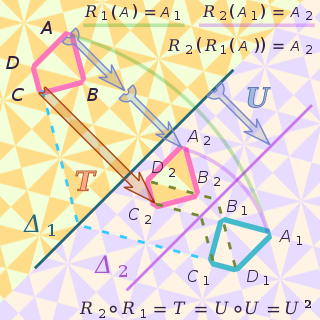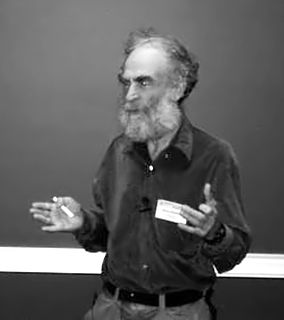Related Research Articles
The Nash embedding theorems, named after John Forbes Nash, state that every Riemannian manifold can be isometrically embedded into some Euclidean space. Isometric means preserving the length of every path. For instance, bending but neither stretching nor tearing a page of paper gives an isometric embedding of the page into Euclidean space because curves drawn on the page retain the same arclength however the page is bent.

The Gauss–Bonnet theorem, or Gauss–Bonnet formula, is a relationship between surfaces in differential geometry. It connects the curvature of a surface to its Euler characteristic.

Riemannian geometry is the branch of differential geometry that studies Riemannian manifolds, smooth manifolds with a Riemannian metric, i.e. with an inner product on the tangent space at each point that varies smoothly from point to point. This gives, in particular, local notions of angle, length of curves, surface area and volume. From those, some other global quantities can be derived by integrating local contributions.

In mathematics, an isometry is a distance-preserving transformation between metric spaces, usually assumed to be bijective.
In differential geometry, the Ricci curvature tensor, named after Gregorio Ricci-Curbastro, is a geometric object which is determined by a choice of Riemannian or pseudo-Riemannian metric on a manifold. It can be considered, broadly, as a measure of the degree to which the geometry of a given metric tensor differs locally from that of ordinary Euclidean space or pseudo-Euclidean space.
In Riemannian geometry, the sectional curvature is one of the ways to describe the curvature of Riemannian manifolds with dimension greater than 2. The sectional curvature K(σp) depends on a two-dimensional linear subspace σp of the tangent space at a point p of the manifold. It can be defined geometrically as the Gaussian curvature of the surface which has the plane σp as a tangent plane at p, obtained from geodesics which start at p in the directions of σp. The sectional curvature is a real-valued function on the 2-Grassmannian bundle over the manifold.
In Riemannian geometry, the scalar curvature is the simplest curvature invariant of a Riemannian manifold. To each point on a Riemannian manifold, it assigns a single real number determined by the intrinsic geometry of the manifold near that point. Specifically, the scalar curvature represents the amount by which the volume of a small geodesic ball in a Riemannian manifold deviates from that of the standard ball in Euclidean space. In two dimensions, the scalar curvature is twice the Gaussian curvature, and completely characterizes the curvature of a surface. In more than two dimensions, however, the curvature of Riemannian manifolds involves more than one functionally independent quantity.
In differential geometry, a pseudo-Riemannian manifold, also called a semi-Riemannian manifold, is a differentiable manifold with a metric tensor that is everywhere nondegenerate. This is a generalization of a Riemannian manifold in which the requirement of positive-definiteness is relaxed.
In mathematics, the uniformization theorem says that every simply connected Riemann surface is conformally equivalent to one of three Riemann surfaces: the open unit disk, the complex plane, or the Riemann sphere. In particular it implies that every Riemann surface admits a Riemannian metric of constant curvature. For compact Riemann surfaces, those with universal cover the unit disk are precisely the hyperbolic surfaces of genus greater than 1, all with non-abelian fundamental group; those with universal cover the complex plane are the Riemann surfaces of genus 1, namely the complex tori or elliptic curves with fundamental group Z2; and those with universal cover the Riemann sphere are those of genus zero, namely the Riemann sphere itself, with trivial fundamental group.

In the mathematical field of differential geometry, the Ricci flow, sometimes also referred to as Hamilton's Ricci flow, is a certain partial differential equation for a Riemannian metric. It is often said to be analogous to the diffusion of heat and the heat equation, due to formal similarities in the mathematical structure of the equation; however, it exhibits many phenomena not present in the study of the heat equation. Many results for Ricci flow have also been shown for the mean curvature flow of hypersurfaces.

Shing-Tung Yau is an American mathematician and the William Caspar Graustein Professor of Mathematics at Harvard University.
In mathematics, the Chern theorem states that the Euler-Poincaré characteristic of a closed even-dimensional Riemannian manifold is equal to the integral of a certain polynomial of its curvature form.

In differential geometry, the holonomy of a connection on a smooth manifold is a general geometrical consequence of the curvature of the connection measuring the extent to which parallel transport around closed loops fails to preserve the geometrical data being transported. For flat connections, the associated holonomy is a type of monodromy and is an inherently global notion. For curved connections, holonomy has nontrivial local and global features.

Mikhael Leonidovich Gromov is a Russian-French mathematician known for his work in geometry, analysis and group theory. He is a permanent member of IHÉS in France and a Professor of Mathematics at New York University.
Myers' theorem, also known as the Bonnet–Myers theorem, is a celebrated, fundamental theorem in the mathematical field of Riemannian geometry. It was discovered by Sumner Byron Myers in 1941. It asserts the following:

In mathematics, a symmetric space is a pseudo-Riemannian manifold whose group of symmetries contains an inversion symmetry about every point. This can be studied with the tools of Riemannian geometry, leading to consequences in the theory of holonomy; or algebraically through Lie theory, which allowed Cartan to give a complete classification. Symmetric spaces commonly occur in differential geometry, representation theory and harmonic analysis.
In the mathematical field of differential geometry, a smooth map from one Riemannian manifold to another Riemannian manifold is called harmonic if its coordinate representatives satisfy a certain nonlinear partial differential equation. This partial differential equation for a mapping also arises as the Euler-Lagrange equation of a functional generalizing the Dirichlet energy. As such, the theory of harmonic maps encompasses both the theory of unit-speed geodesics in Riemannian geometry, and the theory of harmonic functions on open subsets of Euclidean space and on Riemannian manifolds.
In mathematics, Hopf conjecture may refer to one of several conjectural statements from differential geometry and topology attributed to Heinz Hopf.
In mathematics, a Riemannian manifold is said to be flat if its Riemann curvature tensor is everywhere zero. Intuitively, a flat manifold is one that "locally looks like" Euclidean space in terms of distances and angles, e.g. the interior angles of a triangle add up to 180°.
In Riemannian geometry, Cheng's eigenvalue comparison theorem states in general terms that when a domain is large, the first Dirichlet eigenvalue of its Laplace–Beltrami operator is small. This general characterization is not precise, in part because the notion of "size" of the domain must also account for its curvature. The theorem is due to Cheng (1975b) by Shiu-Yuen Cheng. Using geodesic balls, it can be generalized to certain tubular domains.
References
- ↑ Ruggiero, Rafael Oswaldo (2000), "Weak stability of the geodesic flow and Preissman's theorem", Ergodic Theory and Dynamical Systems, 20 (4): 1231–1251, doi:10.1017/S0143385700000663, MR 1779401 .
- ↑ Grant, Alexander (2012), Preissman's theorem (PDF), University of Chicago Mathematics Department.